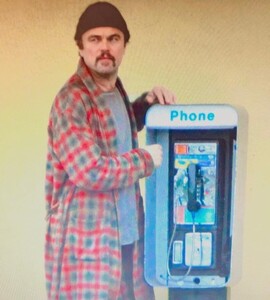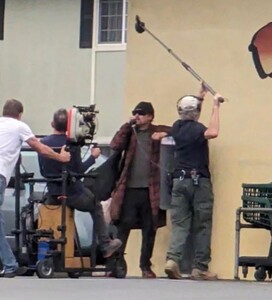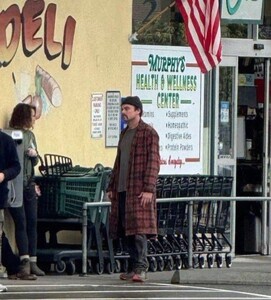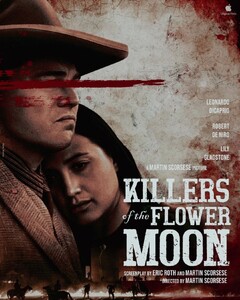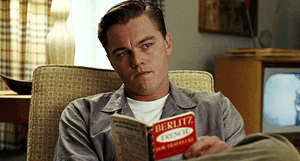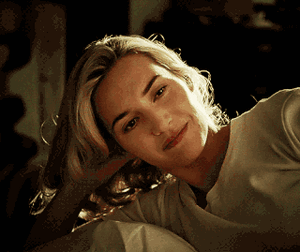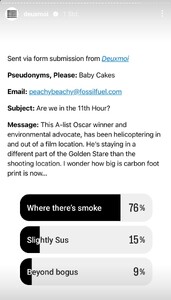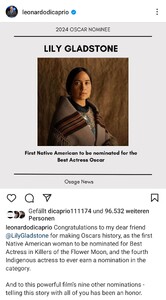
Everything posted by Jade Bahr
-
Margot Robbie
- Léa Seydoux
CAN'T WAIT!!!!!!!!!!!!!!!!!!!!!!!!- Leonardo DiCaprio - (Please Read First Post Prior to Posting)
- Leonardo DiCaprio - (Please Read First Post Prior to Posting)
@Pami LOVE LOVE LOVE this look 😍 "the DiCaprio magic" 💯 Edit: Ok Appian Way is still producing. https://deadline.com/2024/01/chris-rock-directs-another-round-remake-mads-mikkelsen-appian-way-makeready-fifth-season-1235807800/ So it's probably safe to say Leo is no longer involved in this unnecessary remake? Thank god. Chris Rock to Direct ‘Another Round’ Remake- Leonardo DiCaprio - (Please Read First Post Prior to Posting)
First close look of Leo on PTA set in Eureka. (WATCH) First Look at Leonardo DiCaprio In Character for New Paul Thomas Anderson Film Currently Filming in Humboldt Source I'm already intrigued 🤩😁- Vittoria Ceretti
- Leonardo DiCaprio - (Please Read First Post Prior to Posting)
Major Leonardo DiCaprio movie has officially begun filming in Northern California Production appears to be underway in Northern California for the Leonardo DiCaprio movie with the working title “BC Project” after residents reported clusters of police cars, camera crews and Warner Bros. reps in the Redwood Region earlier this week. The film also stars Sean Penn and Regina Hall, and is written and directed by auteur Paul Thomas Anderson, who is known for classics like “Boogie Nights,” “There Will Be Blood” and his latest coming-of-age romance “Licorice Pizza.” Details surrounding the plot of the film remain under wraps, but more information was quietly released on its IMDb page in recent days. Producers Sara Murphy (“If Beale Street Could Talk”), JoAnne Sellar (“There Will Be Blood”) and Adam Somner (“Licorice Pizza”) are now attached to the project, as is on-set painter Mike Reiber (“Babylon.”) Extras casting directors Tracy Dixon (“Super 8”) and Kelly Hunt (“Ford v Ferrari”), whose names were listed on a local casting call for “BC Project,” are also now confirmed among the crew. Meanwhile, Eureka was officially named as at least one of the filming locations, and production began on Jan. 21, per IMDb. It makes sense that the film now has a confirmed costume designer, too: Mark Bridges of “The Artist.” The staff of the Hospice Shop Thrift Store in Arcata said that over the past two weeks, representatives for the film have shown up at their store on H Street “at least four to five times.” The crew spent at least an hour at the thrift shop putting together a massive pile of men’s clothing, fitnesswear and some dresses, Tia Baratelle, director of development for Hospice of Humboldt, told SFGATE. “The first time they checked out, our manager was ringing them up, and asked if they ran a consignment shop or something because of how much they were buying,” Baratelle said. “It was at least a thousand dollars’ worth of clothes. That’s when one of the guys looked at her and said, ‘We’re from that movie.’ Of course she knew what he meant.” As they were leaving, Baratelle said one of the crew then jokingly asked the manager, “Do you think we have enough stuff?” She told him they could “always come back if they didn’t.” On subsequent visits, they returned in search of home decor, including flowerpots and teapots, as well as pet collars and leashes and even more clothing. “They’re totally tight-lipped and aren’t sharing details, but said, ‘You might be seeing it in the closets.’ It might be used for props,” Baratelle said. While Baratelle admitted she’s not much of a movie buff, and seemed pretty nonplussed by all of the hubbub surrounding recent filming — “I’ve lived up here since ’99, and it happens pretty often,” she said — she’s excited to check out the movie once it’s released in theaters, and wouldn’t mind seeing a celebrity or two. “Whether it’s from movie folks or not, we appreciate any support we can get,” she said, noting all of the proceeds earned at the thrift store go toward Hospice of Humboldt’s mission to provide grief services, palliative and hospice care in the area. “It’s great that they’re supporting our local economy.” Chris Reynoso, who runs Cafe Brio in Arcata, said he’s also noticed some production assistants from the film grabbing breakfast at his business and paying with a card that was labeled “BC Project.” Some of them also bought a “hippie-looking” recycled wood wall hanging made by local artist Zak Shea that he suspects may be used in the film. “We’re all thrilled,” Reynoso said. “It’s nice they were here because they helped bring in some business during a normally slow time of year.” On social media, people posted sightings of an unusual line of police cars going northbound along the safety corridor on Highway 101 and slowing traffic near Arcata earlier this week. One resident shared a video from the window of Gallagher’s Irish Pub in Eureka of more police cars with their lights flashing, followed by a Porsche Cayenne with a crane car mount affixed to it as they drove along Redwood Highway. A Warner Bros. truck was also seen parked near the Domino’s in Arcata earlier this month, Redwood News reported. Cassandra Hesseltine, film commissioner for the Humboldt-Del Norte Film Commission, confirmed with SFGATE that a project was being shot in the area but could not verify how long production would last, nor its ties to the Anderson film. She noted residents may notice “some noise levels” in the coming days, but that shooting wouldn’t be taking place in the middle of the night and was unlikely to disrupt anyone’s sleep. “The biggest thing we want people to do in the near future is to pay attention to roads and rerouting of activity,” Hesseltine told SFGATE over the phone Tuesday. “People will be notified of impacts regarding road closures or ITC [intermittent traffic control] and we’ve asked that production has flaggers and safety officers on site. In turn, we ask people to take their time, be careful and appropriate if they see anything. We appreciate everyone’s patience at this time, and anything anyone runs into is just temporary.” The Humboldt County Public Works Department told SFGATE on Tuesday that no road closures are related to filming at this time. Eureka High School is reportedly one of the filming locations for the movie. One of the previously announced collaborators on “BC Project” was casting director Cassandra Kulukundis (“Inherent Vice”), who in 2022 posted a casting call for an Anderson film in need of a “15 to 16”-year-old “teenage girl who excels at Martial Arts,” per World of Reel. It’s unclear if the notice is related to another project the director is working on, but notably, Eureka High School shared a casting call last month for “a big movie” that was going to be filmed on campus, seeking paid extras aged 16 and older. SFGATE reached out to the school district for confirmation Tuesday, but was told in an email that “Eureka City Schools is unable to discuss any of the details regarding our involvement in the project, in any form, due to signed Non-Disclosure Agreements.” As more details are likely to emerge in the coming weeks while shooting continues, Hesseltine is asking people to be respectful of the cast and crew involved. The film commission office has been “flooded with phone calls” before, which can be more disruptive to production than people may realize, she said. “It’s interesting what happens when people get excited,” she said. “We want them to be, because that keeps the industry going, but there’s a point that it becomes a burden, and it becomes unsafe, even for a film commissioner.” She asked locals and film enthusiasts to be understanding if she can’t answer all of their questions right away — the payoff will be worth it. “We want to celebrate a movie when it comes out,” she said. “I know it sounds like we’re all being snooty or secretive, but we have to protect the project, the people involved and the intellectual property, and need folks to cooperate in order to do that.”- Vittoria Ceretti
- Leonardo DiCaprio - (Please Read First Post Prior to Posting)
- Leonardo DiCaprio - (Please Read First Post Prior to Posting)
Some nice -even though bit older- words from Nolan “He’s going to be a movie star forever”: Christopher Nolan Only Considers 1 Actor to Be a True Superstar and That’s Not Cillian Murphy or Christian Bale Christopher Nolan thinks that Leonardo DiCaprio has a timeless aura as an actor, something be believes only Al Pacino and Jack Nicholson had. Christopher Nolan has a lot of sway in the world of Hollywood and saw one particular young actor as a true talent, for whom he predicted a very promising career. While many would assume it be an actor who he has worked with multiple times, like Christian Bale and Cillian Murphy, that is not the case. This is why it is extremely surprising to find out that the actor that Nolan thinks to be exceptionally talented, is someone he has worked with only once. The actor in question is none other than Leonardo DiCaprio. Christopher Nolan has a lot of sway in the world of Hollywood. Being responsible for some of the most culturally significant masterpieces of recent times, he has made a name for himself as one of the most hardcore directors of all time, having very specific techniques to make his art. These require people who can keep up with his higher level filmmaking, which usually results in some of the biggest names in the industry starring in his projects. With these, and the fact that he is one of the most respected filmmakers right now, has led to his word holding a lot of power. This is why, fans would be more than interest to find out which actor he thinks is a true talent and has a very promising career. While many would assume it be an actor who he has worked with multiple times, like Christian Bale and Cillian Murphy, however, this is not the case. Christopher Nolan Has Worked With Some Of The Biggest Actors Of All Time Christopher Nolan‘s films are well-known for receive some or the other kind of nomination, be it in the categories of Best Director, Best Picture, and Best Screenplay, or Best Actor and Actress. A fact that is well-known is that his films feature a cast that is equal to genius. The filmmaker has worked with some of the biggest names in Hollywood through this. In his Dark Knight trilogy, he got the opportunity to work with Christian Bale, Heath Ledger, and Morgan Freeman. In his 2014 film, Interstellar, he worked with Matthew McConaughey, Anne Hathaway, and Matt Damon. He is also known for having the same actor star in more than one of his films, with Cillian Murphy being an excellent example, as well as Damon, Hathaway, and Michael Caine. This is why it is extremely surprising to find out that the actor that Nolan thinks to be exceptionally talented, is someone he has only worked with only once. The actor in question is none other than Leonardo DiCaprio. Why Christopher Nolan Consider Leonardo DiCaprio To Be A True Superstar? During the press tour of his 2010 film, Interstellar, Christopher Nolan spoke very fondly of Leonardo DiCaprio, who played the protagonist of this film and did an exceptional job at it. Talking to Rolling Stone, he mentioned that he believes that the actor has a very distinct trait that very few possess in the film industry. He thinks that DiCaprio’s presence as an actor is timeless, comparing him to legends like Al Pacino, and Jack Nicholson. “He has that timeless quality about him, like a Jack Nicholson or an Al Pacino,” said Christopher Nolan, “He’s going to be a movie star forever.” Nolan’s prediction from more than ten years ago seems to be standing true to this very date, considering the fact that the actor recently starred in Martin Scoresese’s The Killers of the Flower Moon. This film received immense critical acclaim from all sides of Hollywood. So much so, that it was nominated for multiple Oscars. Source- Leonardo DiCaprio - (Please Read First Post Prior to Posting)
- Leonardo DiCaprio - (Please Read First Post Prior to Posting)
Can't believe he's turning 50 this year 🤯 Former Teen Stars Turning 50 in 2024 From Leonardo DiCaprio to half of the 'Saved by the Bell' cast, see which stars are hitting the milestone this year I can still remember watching TITANIC for the first time aka my 1rst Leo movie. Good lord I was in awe with Jack Dawson the same way Rose was 😍- Leonardo DiCaprio - (Please Read First Post Prior to Posting)
^The original book also takes places in the 80s and 60s if I'm correct. So if it's really a "modern version" of Vineland I think it will be a more loose adaption of the book. I also watched dozens of movies where the actors look couldn't fit less with the original description of the book 😄 Has anyone seen PTAs other Pynchon adaption with Joaquin Phoenix? And if so how close is it to the book?- Leonardo DiCaprio - (Please Read First Post Prior to Posting)
Another time. Another Wheeler 😄 I would be much more thrilled if the other female Wheeler also were involved in this PTA project - Vineland or not 😙- Leonardo DiCaprio - (Please Read First Post Prior to Posting)
Means he would play the "bad guy" again... at least in the book this Vond guy seems some sort of villain.- Last movie you saw...
- Leonardo DiCaprio - (Please Read First Post Prior to Posting)
So far we just can't seem to get rid of VINELAND 😄- Leonardo DiCaprio - (Please Read First Post Prior to Posting)
Love the Variety interview + shoot 😍 LMAO Not really Leo related but loved him in KOTFM so can't wait seeing him in this show!- The "What Are You Thinking About Right Now?" PIP
Britney fans giving Just Timberlakes "comeback" a hard time LOL- Leonardo DiCaprio - (Please Read First Post Prior to Posting)
- Leonardo DiCaprio - (Please Read First Post Prior to Posting)
Why should he present best picture? Aren't the winners of the year before mostly the presenters or is that only in the actors categories? @Pami If I hear Eureka I have to think about the tv show. Not that I ever watched it LOL However it's a town in North California where PTA is shooting his new movie with Leo... which is hopefully not Vineland because apparently the story of the book set also place in Eureka.- Lily Gladstone
Lily Gladstone to Star in Charlie Kaufman-Penned ‘The Memory Police’ Here’s the good news. Charlie Kaufman has a new script that will be turned into a film. He’s written “The Memory Police”, an adaptation of the acclaimed 1994 science fiction novel by Yoko Ogawa. Some additional good news. Lily Gladstone will star in the film and this is set to be her next project after the acclaim she received for her Oscar-nominated performance in “Killers of the Flower Moon.” In fact, Martin Scorsese is also set as the executive producer. Now, here’s the concerning news. Kaufman isn’t directing. Instead, Reed Morano will helm the film, she’s known for her work on TV’s “The Handmaid’s Tale,” and two lukewarm indie films (“I Think We’re Alone Now” and “The Rhytmn Section”). She has visual flair, that’s for sure, but can she make a good film out of Kaufman’s script? Here’s the synopsis for “The Memory Police”: Ogawa’s novel is a parable taking place on an unnamed island off an unnamed coast where a majority of the island’s residents are subject to collective amnesia. They endure a process of forgetting things, including objects, people and daily rituals, with the amnesia enforced by an organization called The Memory Police. In the story, a novelist tries to hide her editor, who can still remember, from the Memory Police, while he encourages her to write her book. Kaufman, the mind-tripping writer behind “Being John Malkovich,” “Eternal Sunshine of the Spotless Mind,” and “Adaptation,” hasn’t directed a film since 2020’s “I’m Thinking of Ending Things.” His other directing credits are 2008’s “Synecdoche, NY” and 2015’s “Anomalisa.” Last year, Kaufman spoke of a script he had written for Ryan Gosling to star in, which he wanted to direct. He was looking for funding, but there hasn’t really been an update since then. In the meantime, Kaufman penned Netflix’s animated “Orion and the Dark,” set to stream in February, and based on a 2014 book by Emma Yarlett. Described as a “darkly whimsical” film, it was directed by animator Sean Charmatz in his feature debut.- Leonardo DiCaprio - (Please Read First Post Prior to Posting)
- Leonardo DiCaprio - (Please Read First Post Prior to Posting)
If he attended the oscars without being nominated just as Lilys supportive +1 I swear the world would collapse. Best free pr ever. Just sayin. 😙 It's also a bit different than 1998 I think. He's much more mature now (mostly *cough) and he cares about KOTFM and the highly important message of it like he cares for Marty and Lily and DeNiro. And even though he might cared for Kate back then he never felt that amount of commitment to Titanic nor James Cameron let's be real.- Leonardo DiCaprio - (Please Read First Post Prior to Posting)
- Léa Seydoux
Account
Navigation
Search
Configure browser push notifications
Chrome (Android)
- Tap the lock icon next to the address bar.
- Tap Permissions → Notifications.
- Adjust your preference.
Chrome (Desktop)
- Click the padlock icon in the address bar.
- Select Site settings.
- Find Notifications and adjust your preference.
Safari (iOS 16.4+)
- Ensure the site is installed via Add to Home Screen.
- Open Settings App → Notifications.
- Find your app name and adjust your preference.
Safari (macOS)
- Go to Safari → Preferences.
- Click the Websites tab.
- Select Notifications in the sidebar.
- Find this website and adjust your preference.
Edge (Android)
- Tap the lock icon next to the address bar.
- Tap Permissions.
- Find Notifications and adjust your preference.
Edge (Desktop)
- Click the padlock icon in the address bar.
- Click Permissions for this site.
- Find Notifications and adjust your preference.
Firefox (Android)
- Go to Settings → Site permissions.
- Tap Notifications.
- Find this site in the list and adjust your preference.
Firefox (Desktop)
- Open Firefox Settings.
- Search for Notifications.
- Find this site in the list and adjust your preference.

_X.thumb.png.4a702b00334ffbb3eeaadc0ce1928816.png)
